Content
Published:
This is an archived release.
Increased economic activity, yet minor fall in emissions
Norwegian economic activity grew in 2012, however without an increase in total emissions of greenhouse gases. The emission intensity decreased from the previous year with 3.7 per cent. Both service sectors and emission intensive industries like the inland water, maritime transport and manufacturing industries have contributed to this decrease.
| 2011 | 2012 | Change in per cent | ||
|---|---|---|---|---|
| 2011 - 2012 | Since 1990 | |||
| Output in constant 2005 prices. NOK million | 3 537 770 | 3 651 965 | 3.2 | 94.5 |
| Greenhouse gas emissions. 1 000 tonnes CO2-equivalents | 58 825 | 58 452 | -0.6 | 0.0 |
| Emission intensity for greenhouse gases. Tonnes CO2-equivalents/output in NOK million | 16.6276 | 16.0057 | -3.7 | -48.6 |
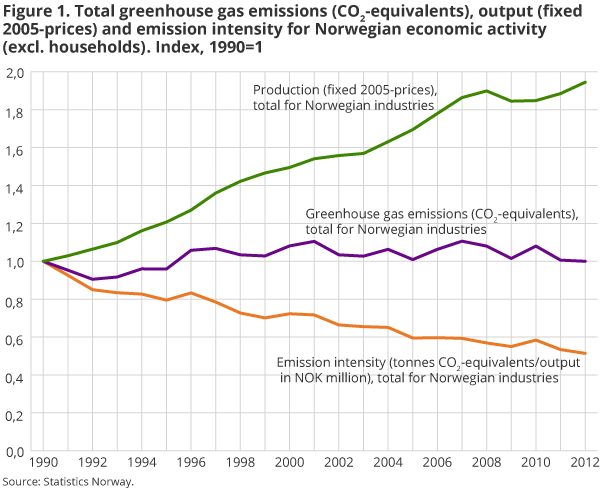
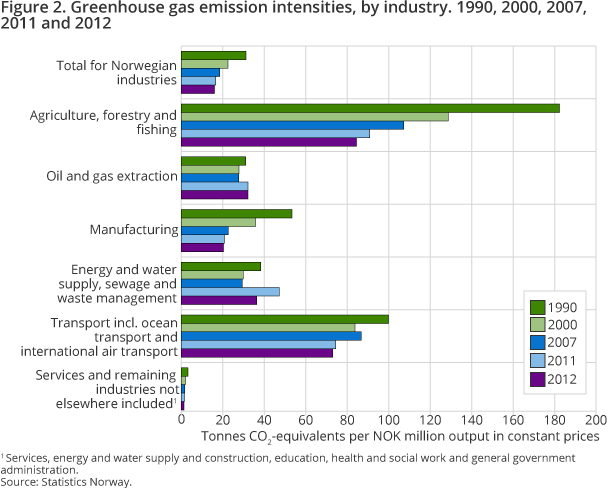
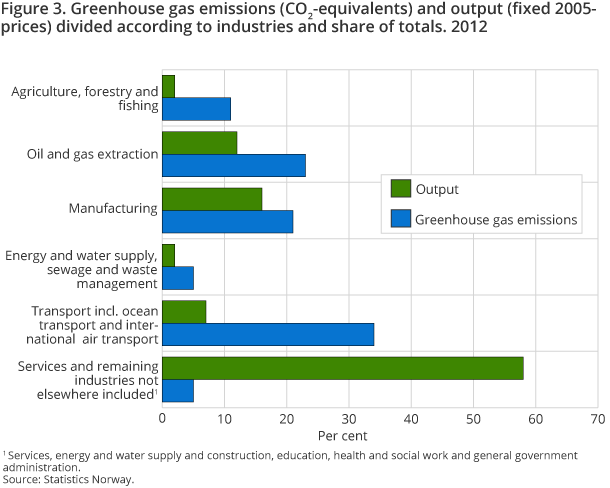
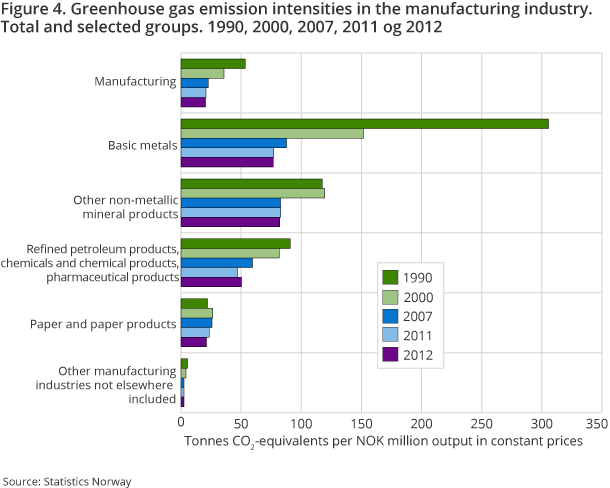
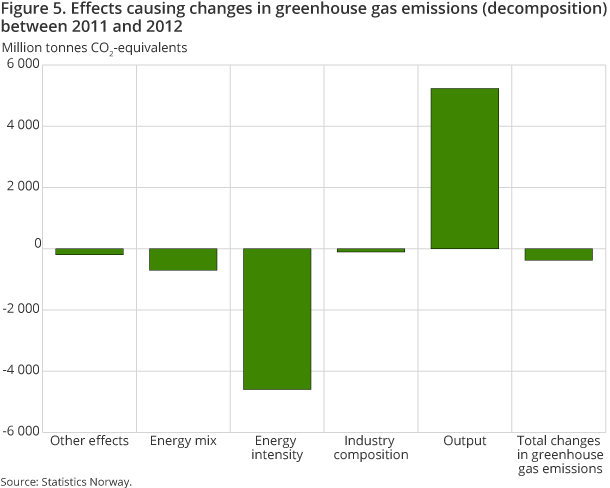
Based on detailed industry data from the emissions to air accounts and the national accounts, emission intensity for the Norwegian economic activity for the period 1990-2012 have been estimated.
Unlike the national emission figures that are reported as part of the Kyoto agreement, and which are calculated using a territorial definition of Norway, the figures presented here also include emissions from maritime transport and international air transport in order to link emissions to Norwegian economic activity. The figures are broken down into industries in order to analyse possible correlations between economic growth, energy use and emissions to air, and to identify the various effects causing changes in emissions (decoupling).
Since 1990, emission intensity in Norwegian manufacturing has been reduced by almost 50 per cent, reaching a level of 16.0 tonnes CO2 equivalents per produced unit (as measured in constant 2005 prices) in 2012.
The changes in emission intensity in Norway are partly due to technological changes, changes in the mix of energy products used, a shift towards more energy-efficient production and structural changes. A shift from the use of fossil fuels towards fuels based on renewable sources reduces emissions as well. This is also the case if there is a structural change in the economy from, for example, manufacturing industries to service industries.
Growth in production, decrease in greenhouse gas emissions
In 2012, production in the Norwegian economy grew by 3.2 per cent. This is the highest annual growth since 2007 which roughly corresponds to increased production in the service sectors and the electricity industry, i.e. industries that in Norway are not very emission intensive. The growth in production in 2012 was not accompanied by an increase in greenhouse gas emissions.
Greenhouse gas emissions related to Norwegian economic activity totalled 58.5 million tonnes of CO 2 equivalents in 2012. This was a decrease of 0,6 per cent compared to 2011. The decrease in greenhouse gas emissions was highest in the production of metals, the pulp and paper industry and in gas supply. Increased emissions from land- and air transport activities, fisheries and oil and gas production industries halted the total decrease in greenhouse gas emissions.
A decomposition analysis looking at the effects causing changes in greenhouse gas emissions showed that the structural changes between industries and changes in the composition of consumed energy products, as well as direct measures to reduce emissions and energy consumption, have reduced the total emissions of greenhouse gases with 5.6 million tonnes CO 2 equivalents since 2011. This more than compensates for the effect of increased output, which is estimated at an increase of 5.2 million tonnes.
Large variations between industries
The decrease in the overall emission intensity in 2012 was related to production growth in less emission intensive industries, while emissions in more emission intensive industries fell during the same period of time.
Trends for individual industries show some differences, though nationally the correlation between economic growth and emissions of greenhouse gases seems weak. It is particularly within industries that constribute the most to the greenhouse gas emissions, like the transport industries, the manufacturing industries and the oil and gas production industries, that the challenges of reducing emissions without reducing the production growth are the biggest.
The emission intensity for greenhouse gases for the manufacturing industries fell by 2.6 per cent in 2012, while for the transport sector in total it fell by 2 per cent. The total production (as measured in constant 2005 prices) increased both in the manufacturing and the transport sectors. The greenhouse gas missions fell in the manufacturing industries, while the transport sector saw an increase. The emission intensity for the oil and gas production industry remained stable in 2012.
Continued decrease in emission intensity for the manufacturing industries
Since 1990, emission intensity in Norwegian manufacturing has almost been halved. This is due to a growth in production in some manufacturing industries with relatively small emission intensities, but also due to the fact that industries such as production of metals and petroleum refining, chemicals and pharmaceuticals have improved their emission effectiveness. These industries emit almost three quarters of the total greenhouse gas emissions from manufacturing industries, and have almost one fourth of the total production.
In 2012 the improvement in the overall emission intensity of the manufacturing industry was mainly due to the development in the pulp and paper industries (several establishments closed down) and the production of metals (decrease in emission of PFCs) where the decrease in the emission of greenhouse gases was higher than the decrease in production. In 2012 the emission intensity in the petroleum refining, chemicals and pharmaceuticals increased, and halted the overall decrease in the emission intensity for the total manufacturing industries.
Emission intensity up for land and air transport
For the transport industries, the picture is complex. Emission intensity for the transport sector as a whole fell by 2 per cent in 2012 due to the development in inland maritime and coastal transport.
The estimations of the emission from maritime transport are uncertain, particularly the estimations based on the preliminary national accounts’ figures. Looking at the overall emission intensity excluding maritime transport, there was a decrease of 3.5 per cent in 2011. The emission intensity trend, dating back to 1990 is more or less the same with or without maritime ocean transport.
Unchanged emission intensity in oil and gas
Emission intensity for the production of oil and gas extraction has seemingly not shown any improvement since 1990, although there were large variations between the different fields. In 2012, the emission intensity in the oil and gas industry is almost unchanged compared to the previous year since both production and emissions increased with approximately the same magnitude.
The increase in production in the oil and gas industry was attributed to the growth in production of natural gas and primarily due to the commencement of three new gas fields. A continued decline in oil production slowed the growth in total production for the oil and gas industry, resulting in a total increase (at constant prices) at 0.5 per cent. The greenhouse gas emissions in this industry increased in 2012 by 0.6 per cent after a decline in emissions in 2011.
Additional information
Contact
-
Ingrid Semb Weyer
E-mail: ingrid.semb.weyer@ssb.no
tel.: (+47) 40 90 23 51
-
Trine Heill Braathu Randen
E-mail: trine.heill.braathu.randen@ssb.no
tel.: (+47) 91 10 67 45
